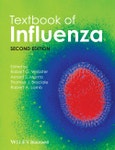The Textbook of Influenza is a comprehensive resource covering all aspects of influenza, from the genetic and molecular biology of the virus through to clinical aspects of the disease and the latest drug developments and treatments. This new edition has been completely revised and reflects the integration of disciplines concerning the emergence, evolution, pathogenesis and control of influenza viruses in the field of human and veterinary public health.
Textbook of Influenza examines the lessons learnt from the latest pandemic and provides the current state of knowledge for many yet unresolved issues related to virus origin, spread, pathogenesis and disease severity to better prepare for future pandemics. It covers the background to recent advances in influenza genomics and reverse genetics which have allowed the identification of virus virulence factors and the analysis and reconstruction of influenza viruses such as the 1918 Spanish flu strain.
This new edition is divided into eight key sections, containing chapters co-written by international experts from both the clinical and scientific communities, covering:
- Influenza Perspectives
- Structure and Replication
- Evolution and Ecology
- Epidemiology and Surveillance
- Immunology
- Vaccines and Vaccine Development
- Clinical Aspects and Antivirals
- Public Health
Textbook of Influenza is for all those working in the area of influenza including clinical and basic scientists, immunologists, molecular and structural virologists, public health officials and global pandemic control planners.
Table of Contents
List of contributors, ix
Foreword to the second edition, xiv
Preface to the second edition, xvi
Acknowledgments, xvii
PART 1 Influenza: Perspective
1 Human influenza: One health, one world, 3
Daniel B. Jernigan and Nancy J. Cox
2 Influenza pandemics: History and lessons learned, 20
Arnold S. Monto and Robert G. Webster
PART 2 Structure and replication
3 Structure, disassembly, assembly, and budding of influenza viruses, 37
Debiprosad Nayak, Sakar Shivakoti, Rilwan A. Balogun, Gwendolyn Lee, and Z. Hong Zhou
4 The virus genome and its replication, 57
Robert M. Krug and Ervin Fodor
5 Influenza glycoproteins: Hemagglutinin and neuraminidase, 67
Rupert J. Russell, Steven J. Gamblin, and John J. Skehel
6 Proton channels of influenza A and B viruses, 101
Chunlong Ma, Lawrence H. Pinto, and Robert A. Lamb
7 The NS1 protein: A master regulator of host and viral functions, 114
Robert M. Krug and Adolfo García-Sastre
8 Structure and function of the influenza virus replication machinery and PB1-F2, 133
Andrew Mehle and Jonathan A McCullers
9 The genome and its manipulation: Recovery of the 1918 virus and vaccine virus generation, 146
Gabriele Neumann and Yoshihiro Kawaoka
10 Pathogenesis, 157
Hans Dieter Klenk, Wolfgang Garten, and Mikhail Matrosovich
PART 3 Evolution and ecology of influenza viruses
11 Ecology and evolution of influenza viruses in wild and domestic birds, 175
Ron A.M. Fouchier and Yi Guan
12 Influenza in swine, 190
Richard Webby and Juergen Richt
13 Equine/Canine/Feline/Seal influenza, 203
Thomas M. Chambers, Edward J. Dubovi, and Ruben O. Donis
14 Emergence and Evolution of the 1918, 1957, 1968, and 2009 pandemic virus strains, 218
Taia T. Wang and Peter Palese
PART 4 Epidemiology and surveillance
15 Influenza surveillance and laboratory diagnosis, 231
Maria Zambon
16 Epidemiology of influenza, 250
Marc-Alain Widdowson and Arnold S. Monto
PART 5 Immunology of influenza
17 Innate immunity, 269
Akiko Iwasaki and Malik Peiris
18 Antibody-mediated immunity, 283
Nicole Baumgarth,Michael C. Carroll, and Santiago Gonzalez
19 Cell-mediated immunity, 298
Stephen J. Turner, Peter C. Doherty, and Anne Kelso
PART 6 Vaccines and vaccine development
20 Immunogenicity, efficacy of inactivated/live virus seasonal and pandemic vaccines, 313
Wendy A. Keitel, Kathleen M. Neuzil, and John Treanor
21 New approaches to vaccination, 327
Chih-Jen Wei, Damian C. Ekiert, Gary J. Nabel, and Ian A. Wilson
22 Control of influenza in animals, 337
Ilaria Capua and Dennis J. Alexander
23 Influenza vaccine production, 352
Klaus Stöhr
PART 7 Clinical aspects and antivirals
24 Human influenza: Pathogenesis, clinical features, and management, 373
Frederick G. Hayden and Menno D. de Jong
25 Antivirals: Targets and use, 392
Michael G. Ison and Alan Hay
26 The control of influenza and cost-effectiveness of interventions, 419
Carolyn B. Bridges, Samuel K. Peasah, and Martin I. Meltzer
27 Applications of quantitative modeling to influenza virus transmission dynamics, antigenic and genetic evolution, and molecular structure, 434
Marc Lipsitch and Derek Smith
28 Pandemic preparedness and response, 453
Jonathan S. Nguyen-Van-Tam and Joseph Bresee
29 Influenza: The future, 470
Thomas J. Braciale
PART 8 The outbreak of H7N9
30 Appendix, 479
Thomas J. Bracial








